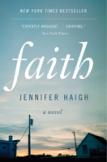Put Out Into the Deep
Two images permeate Jennifer Haigh’s novel Faith: deep water and light. Both images have enriched human expression since human beings first began telling stories. Both images abound in biblical and classical literature: duc in altum; ex umbra in solem. The deep provokes fear and uncertainty in the human heart, while light implies revelation, understanding and truth. Haigh, a New York Times bestselling novelist, ingeniously employs the image of the deep to describe the nature of mature human relationships between men and women and the risks inherent in such relationships. The novel ultimately turns on deep water and the surge of fear that prevents many men and women from diving into either the swirl of the ocean surf or the unknown of a meaningful relationship. Those who are disturbed by the deep stay in the shallows or choose solitude over the vulnerability inherent in giving oneself in love to another person.
The form of Haigh’s novel is driven by the second image. The book represents a set of portraits emerging from Sheila McGann’s family history. Sheila’s account centers around her half-brother Arthur, a priest of the archdiocese of Boston, who is accused of sexually abusing a child during the height of the sexual abuse scandal in the spring of 2002. In her narration, Sheila brings her family secrets from the shadows of the past to the light of the present, in much the same way the Roman Catholic Church was forced to examine its own past and bring what lay hidden there into the light. In the course of presenting her brother Art’s story, Sheila learns a great deal about her mother, Mary, her brother Michael and her father, Ted. The portraits are modified as the story becomes more and more complicated. In the end, Haigh’s book is not about sexual abuse or the life of a priest.
The book is the story of a modern family deeply affected by the past and the cultural context—Irish-Catholic Boston—in which it existed. It is about sexual desire, sexual maturity, fidelity, human relationships, vulnerability, hurt and faith—that is, faith in other people: in one’s spouse, siblings, friends and priests. It is an examination of faith and also of doubt, the storms of alcoholism, resentment, aging, failed relationships and the consequences of self-delusion and dishonesty. It is a juxtaposition of a peculiar man—a man transformed into a priest before he actually became a man—and his younger brother who exudes manhood—an athletic former cop turned successful real estate agent and father of three. The two men represent two strands of the McGann family. Arthur, the priest, carries the surname of his father, who disappeared when Arthur was an infant. Michael, the all-American father, radiates the masculinity and the volatility of his father. In the end, both the peculiar man and the ordinary man prove themselves quite similar to each other.
Two further pairs of juxtapositions arise from the portraits of characters in the novel. There is a parallel between Kath Conlon, a single mother hooked on various prescription and illegal drugs, and Mary McGann, who before her second marriage was a single mother dependent on others as she struggled to sustain herself and her son, Arthur. Finally, there is a comparison between the narrator of the book and her brother Art, the priest. The comparison revolves around solitude and what Sheila refers to in the novel as “tenderness, longing, and regret.” Her own loneliness is set alongside the loneliness she envisions in her brother’s priestly life. Her own fear of commitment and meaningful relationship is juxtaposed with the anxiety, naïveté and lack of intimacy she identifies in her brother. Both Arthur and Sheila fear the water; both fear the deep unknown of human relationships; both fear and distance themselves from what pierces them with discomfort and dread: intimacy, emotion, vulnerability.
Though the book offers intricate character studies, it does not bore. In fact, the reader is driven to race through the text just to find out the resolution of the story. One is not motivated by nagging doubt but by simple, open-ended curiosity and emotion. The book excites and saddens. The story is creative, and the characters, with the exception of the narrator, are all quite vivid and authentic.
Nonetheless, there are bumps along the way. The presentation of the cultural context that encompasses the McGann family is shot through with clichés that grate on the ear of a Bostonian. Everyone is always watching the Red Sox; most everyone works for Raytheon; the blizzard of ’78 is invoked; all of Jamaica Plain is saying the rosary with Cardinal Cushing on the radio; there are shamrock tattoos and claddagh rings. Then there are jimmies and sherbet, three-deckers (which should be triple-deckers), and the Banshee and OFD (originally from Dorchester). But these bumps are smoothed under the roll of the plot.
Faith is a surprising book. As it brings to light the secrets of a family, it sweeps us up like swimmers caught in a breaking wave and deposited somewhere they did not expect. Faith forces one to contemplate one’s relationships and consider one’s fears. The book is an exceptional combination of entertainment and depth.
This article also appeared in print, under the headline “Put Out Into the Deep,” in the December 12, 2011, issue.








